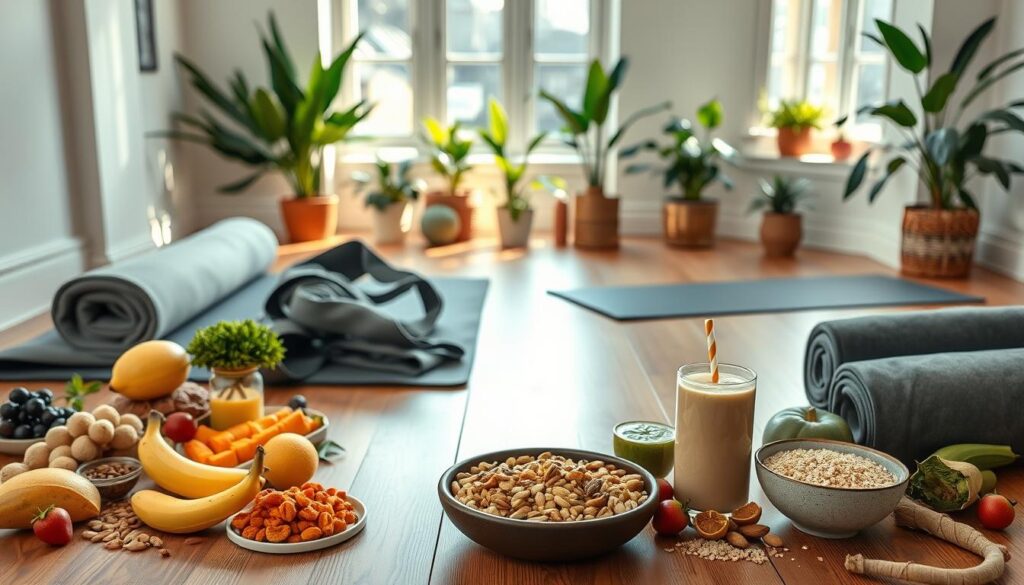Yoga is loved by many for its mind and body benefits. To get the most from your yoga, eating the right foods is key. Eating well before and after yoga boosts energy, helps muscles recover, and improves overall health.

Eating before yoga is all about timing. Experts say to eat a light meal or snack 1-2 hours before. This lets your body digest food without feeling uncomfortable during yoga. Choose foods with proteins, carbs, and healthy fats for lasting energy and muscle support.
Drinking water is also vital before yoga. Drink at least 8 ounces of water 30 minutes before class. For evening classes, drink half your body weight in ounces of water all day. While caffeine can dehydrate, a small snack 60-90 minutes before class can keep your energy up.
After yoga, focus on refueling and rebuilding. Eat a meal with carbs to restore energy and protein for muscle repair. Foods and drinks high in electrolytes, like coconut water, help replace lost minerals. Eat within an hour of finishing your practice to best absorb nutrients and recover.
Key Takeaways
- Eat a light meal or snack 1-2 hours before yoga for optimal digestion and energy
- Stay hydrated by drinking water before and after your practice
- Include a balance of proteins, carbs, and healthy fats in your pre-yoga nutrition
- Replenish energy and support muscle recovery with a post-yoga meal within an hour
- Incorporate electrolyte-rich foods and drinks to replace minerals lost through sweat
The Importance of Proper Nutrition for Yoga
Eating mindfully is key to improving your yoga practice. Choosing foods that are easy to digest helps you stay focused and enjoy your practice more. Eating healthfully not only feeds your body but also deepens your connection with yourself.
Finding the right foods for your yoga can make a big difference. From snacks that give you energy to meals that keep you balanced, making smart choices saves time. Here are some snack ideas that keep you energized without feeling weighed down:
- A banana with almond butter
- A green smoothie made with leafy greens and fruits
- Whole grain toast with avocado
Drinking enough water is also vital for your yoga performance. Dehydration can cause fatigue, cramps, and cloud your mind. Drink 2-3 liters of water a day and hydrate within 30 minutes after yoga. Coconut water is great for replenishing electrolytes after your practice.
When you eat is just as important as what you eat. Give your body 1-2 hours to digest after a snack and 2-3 hours after a meal before yoga. This lets your body focus on your practice without digestive stress.
| Yoga Session Time | Recommended Pre-Yoga Snack | Timing Before Practice |
|---|---|---|
| Morning | Fruits (bananas, berries) | At least 45 minutes |
| Evening | Steamed vegetables, salads, nuts, seeds | 1-2 hours |
By eating mindfully and choosing nourishing foods, you can boost your energy for yoga. Nutrition is a key part of a vibrant and lasting yoga practice, both on and off the mat.
Pre-Yoga Snacks: Energizing and Easy to Digest
Before you start yoga, it’s key to eat snacks that are light and give you energy. Look for snacks with simple carbs, a bit of protein, fat, or fiber. These help keep you energized and flexible during your practice. Here are some great snacks to try before yoga:
Fresh Fruits
Fruits like bananas and apples are great snacks before yoga. They give you quick energy without making you feel heavy. Bananas are also full of potassium, which is good for your nerves and muscles, says the National Institute of Health. Try adding a bit of nut butter for extra protein and energy.
Smoothies
Smoothies are tasty and full of nutrients before yoga. Mix your favorite fruits with Greek yogurt or plant-based protein for a balanced snack. Add spinach or kale for extra vitamins and minerals. Make sure to have your smoothie at least 30 minutes before yoga to digest it well.
Nuts and Seeds
Nuts and seeds are packed with nutrients like protein, healthy fats, and fiber. Almonds and cashews are good choices because they have lots of minerals and vitamins. Enjoy a small amount on their own or with fruit for a good snack before yoga.
| Pre-Yoga Snack | Timing |
|---|---|
| Light snacks (e.g., fruit, nuts) | 30-60 minutes before practice |
| Full meals | 2-3 hours before practice |
Listen to your body and try different snacks to see what works for you. Make sure to give your body time to digest. Experts say wait one to one-and-a-half hours after a light snack and two to three hours after a full meal before yoga.
Timing Your Pre-Yoga Meal
Eating the right amount of food before yoga is important. Eating too much can cause stomach issues. On the other hand, not eating enough can make you feel weak. It’s best to eat a light snack or meal 30 minutes to an hour before your class.
If you have a full meal, wait two to three hours before yoga. This avoids stomach problems during your practice. Choose small portions of whole foods like soup, salad, or veggies for easy digestion and energy.
Light Snacks: 30-60 Minutes Before Practice
For a light snack, try these quick energy boosters:
- Banana and almond butter with greens
- Green juice
- Sprouted toast with avocado
Listen to your body and try different snacks. Avoid foods that can cause discomfort, like smoothies, garlicky foods, and greasy items.
Full Meals: 2-3 Hours Before Practice
For a bigger meal, eat two to three hours before yoga. This gives your body time to digest. Here are some tips for your pre-yoga meal:
| Meal Component | Recommended Amount | Examples |
|---|---|---|
| Carbohydrates | 1-2 servings | Brown rice, quinoa, sweet potato |
| Protein | 1 serving | Grilled chicken, tofu, legumes |
| Vegetables | 1-2 servings | Steamed broccoli, roasted carrots, leafy greens |
Drinking enough water is also key for a good yoga session. Drink 16-20 ounces of water one to two hours before. Rehydrate after to prevent soreness and dehydration. Aim for five to six glasses of water a day.
Foods to Avoid Before Yoga
Before you start your yoga, think about what you’ve eaten. Some foods can upset your stomach and make you feel uncomfortable. Here are some foods to avoid before your next yoga session.
Heavy, Greasy, and Spicy Foods
Heavy, greasy, or spicy foods are hard to digest. They can make you feel sluggish and uncomfortable during yoga. Instead, choose snacks that are light and easy to digest.
Carbonated Drinks and Alcohol
Stay away from carbonated drinks and alcohol before yoga. They can cause bloating and make you dehydrated. Drink water or herbal tea to stay focused and hydrated.
Also, limit high-fiber and acidic foods before yoga. Too much fiber can cause bloating. Acidic foods like citrus fruits can upset your stomach. It’s best to eat them after your practice.
“The key to fueling your yoga practice is to choose foods that are easy to digest, provide sustained energy, and don’t leave you feeling uncomfortable on the mat.”
By avoiding these foods, you’ll have a better yoga experience. You’ll feel more comfortable and energized during your practice.
Hydration: The Key to a Successful Yoga Practice
Staying hydrated is key for a smooth yoga practice. It helps your muscles work well and boosts your mental and physical performance. It’s crucial when doing hot yoga to avoid heat exhaustion and dehydration.
Drink water all day and before your yoga class. But don’t drink too much right before. Aim for eight ounces of water 30 minutes before your session.
You can also hydrate with water-rich foods. Try watermelon, cucumber, juices, or smoothies. They’re tasty and help keep you hydrated without feeling full.
“Proper hydration before and after yoga practice is crucial for maintaining smooth muscle functioning and enhancing mental and physical performance.”
Even a small loss of body fluid can hurt your performance by up to 25 percent. Watch for signs of dehydration like light-headedness, headaches, and dark urine. These are signs you need more water.
Make hydration a part of your yoga routine. Drink when you’re thirsty and take breaks to sip water. With enough water, you’ll enjoy your yoga practice more.
Post-Yoga Nutrition: Replenishing and Rebuilding
After yoga, it’s key to eat a meal that’s balanced. This meal should have carbs, proteins, and fats. These help fix muscles and bring back energy. A study by the National Institute of Health shows that eating protein after exercise helps muscles recover and grow.
Balanced Meals with Carbs and Protein
For your post-yoga meal, aim for carbs to protein in a 3-to-1 ratio. Carbs are vital for energy, with foods like bananas and chickpeas helping muscles recover. Add lean proteins like chicken or tofu to aid in muscle repair.

Electrolyte-Rich Foods and Drinks
Yoga makes you lose important electrolytes through sweat. To get them back, eat foods and drinks rich in sodium, potassium, and magnesium. Good choices include:
- Coconut water
- Watermelon
- Bananas
- Spinach
- Nuts and seeds
Timing Your Post-Yoga Meal
When you eat after yoga matters a lot. Try to eat within 30-60 minutes to help your body absorb nutrients better. If you can’t eat a full meal, a smoothie with wild blueberries and Greek yogurt can help until you can eat more.
| Post-Yoga Snack Ideas | Benefits |
|---|---|
| Greek yogurt parfait with fruit, nuts, and granola | Protein, carbohydrates, and healthy fats for muscle recovery and energy restoration |
| Quinoa bowl with veggies, tofu, or legumes | Complete protein, fiber, and nutrients to support overall health and recovery |
| Smoothie with frozen wild blueberries, banana, mint, Greek yogurt, and kefir or silken tofu | Antioxidants, electrolytes, and easily digestible nutrients for quick replenishment |
Yoga Before or After Eating: Finding the Right Balance
Finding the right time to eat before or after yoga can be tricky. Some say to practice on an empty stomach, but others prefer a light meal or snack. It’s all about what feels right for you and your yoga journey.
If you like practicing on an empty stomach, fasting might suit you. Some yogis enjoy bulletproof coffee to keep them going. But, listen to your body to avoid feeling distracted or losing focus.
If you prefer to eat before yoga, timing is key. Try to eat a light meal or snack two hours before. This way, you get energy without feeling too full. Good snacks include:
- Fresh fruits like bananas, apples, or berries
- Smoothies made with yogurt, fruit, and leafy greens
- A handful of nuts and seeds
- Oatmeal with a touch of honey and cinnamon
- A small serving of quinoa salad or whole-grain wrap
Stay hydrated, but avoid too much water during yoga. It can affect your energy and digestion, mainly in prone poses. Drink water throughout the day and sip as needed during your practice.
| Timing | Food Choices | Benefits |
|---|---|---|
| 2-3 hours before practice | Light, balanced meal (e.g., quinoa salad, whole-grain wrap) | Provides sustained energy without feeling heavy |
| 30-60 minutes before practice | Small snack (e.g., fresh fruit, nuts, smoothie) | Quick energy boost without causing digestive discomfort |
| Immediately before practice | Avoid eating; sip water as needed | Allows for optimal focus and energy flow during practice |
“Finding the ideal pre and post-yoga diet is based on personal experience and may require some trial and error.”
Experiment to find the best eating plan for your yoga practice. The right food and timing can enhance your experience. This way, you can fully enjoy your yoga and get the most out of it.
Adapting Your Diet to Different Styles of Yoga
Fueling your yoga practice is key. The type of yoga you do affects your diet. Different styles need different energy levels and diets. Adjusting your diet to match your yoga class helps you perform better.
Gentle Yoga Styles: Lighter Snacks
For gentle yoga, like restorative yoga, a light snack 30 minutes before class is enough. Fresh fruits are great because they digest quickly. They give you energy without making you feel heavy.

Vigorous Yoga Styles: More Substantial Meals
Vigorous yoga, like vinyasa or power yoga, needs more energy. Eat a bigger meal with complex carbs and lean proteins 2 to 3 hours before. This lets your body digest, so you’re not sluggish during class.
Good pre-yoga meals for vigorous styles include:
- A small bowl of oatmeal with fresh fruit and nuts or seeds
- A whole-grain wrap with hummus, veggies, and lean protein like chicken or tofu
- A smoothie with almond milk, spinach, banana, and plant-based protein powder
Everyone’s body is different. You might need to try a few things to find what works for you. Listen to how you feel during and after yoga. Adjust your diet based on your body’s response. If you have special dietary needs, talk to a nutritionist or your yoga teacher.
Conclusion
Proper nutrition is key to a great yoga practice. Choosing the right foods and timing them well gives you the energy you need. This way, you can enjoy your yoga without feeling tired or uncomfortable.
Energizing snacks like fruits, smoothies, and nuts are great before yoga. Afterward, balanced meals with carbs and protein help you recover. This mix keeps your body and mind in sync.
It’s important to listen to your body and find what works for you. Some like to practice on an empty stomach, while others prefer a light snack. Try different things to see what feels right.
Yoga is about being present and connected with yourself. Let your intuition guide you in choosing foods that support your practice. This way, you can enjoy your yoga more fully.
The secret to better yoga through nutrition is being mindful with your food. Eat wholesome, easy-to-digest foods and drink plenty of water. This creates a strong base for a focused and enjoyable yoga practice.
Explore and find what’s best for you. Let your yoga and nutrition journey grow together in harmony. This will make your practice even more rewarding.



